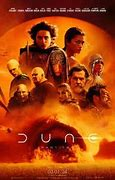Prose fiction is verbal, graphic fiction is visual-verbal and screen drama is audio-visual. Prose science fiction invites us to imagine interstellar spacecraft whereas the visual media show us representations of them. The three media have, respectively: no images, static sequential images and moving images. The impact of moving images accompanied by sounds is vastly greater than that of printed words except maybe to someone with a very vivid imagination.
Thus, I appreciate Poul Anderson's prose narratives in novels like The People Of The Wind and Ensign Flandry and also appreciate the visuals in three different screen adaptations of Dune but the ultimate experience would be good screen adaptations of Anderson's Technic History. Nothing new here but it is on my mind a lot with Dune, Part 2, being released.

11 comments:
Kaor, Paul!
Because of my bad hearing I've always found written texts affecting me far more strongly than movies. But the ability to use subtitles/captions has made films far more accessible, at least on TV.
Ad astra! Sean
Sean,
I went to the second (and authentic) JUDGE DREDD film with a friend, me paying for us both. Very early in the film, he found the violence distressing. He told me afterwards that he had sat with his eyes closed for most of the film! I, of course, told him that he should have whispered to me and gone out.
Paul.
Kaor, Paul!
Violence sells, I fear. That's why Roman gladiatorial games were so popular for centuries, till the rise of a Christianity disapproving of such barbarities led to their abolition.
Ad astra! Sean
I did run across the claim that at least part of the reason the Church disapproved of the gladiatorial games, was not the violence, but the implicit notion that men could save themselves by their own efforts without God's help.
I think it was in episodes 30 and 31 of this podcast.
https://historyonfirepodcast.com/archive
Kaor, Jim!
While it would be good to do research on what was said or written about gladiatorial games in the years leading up to their abolition, that seems far fetched. It seems an implausibly abstract "defense" of those games. I think I did read of Romans who argued gladiatorial games were good because they toughened up people for facing the harsh necessities of life. Absurd, of course, those games did nothing but debase people, appealing to sadism and cruelty.
Ad astra! Sean
Sean: I was (visually) exposed to a fair amount of death and violence as a child.
When I returned here to North America, people seemed... to be blunt... sort of squeamish and wimpy. "Very sheltered", to be polite about it.
Kaor, Mr. Stirling!
Ha, like me! But at least I try to have no tom fool idealistic illusions about myself or the world.
Ad astra! Sean
"read of Romans who argued gladiatorial games were good because they toughened up people for facing the harsh necessities of life."
Also to just observe how different possible opponents fight, so Romans know what they might be up against, so they can think about how to counter the tactic. Only slightly more plausible.
Kaor, Jim!
And as you imply, very implausible! Roman soldiers would be trained and drilled by the legions in how to handle weapons and to fight. In a far systematic and thorough way than by what you would get from watching gladiatorial games. E.g., as described by Flavius Vegetius in his manual DE RE MILITARI.
Ad astra! Sean
Note that Marius' reforms of Roman military training among other things used gladiators as swordsmanship instructors, and copied gladitorial training methods (in part).
By the late Republic, Roman military training was very thorough. People who tried to fight the Romans on their own terms almost always regretted it.
Kaor, Mr. Stirling!
I should have known that the Romans did make some use of gladiatorial methods for training legionaries.
And we certainly see the Marcomanni being very sorry they picked a fight with the Empire in TO TURN THE TIDE!
Ad astra! Sean
Post a Comment